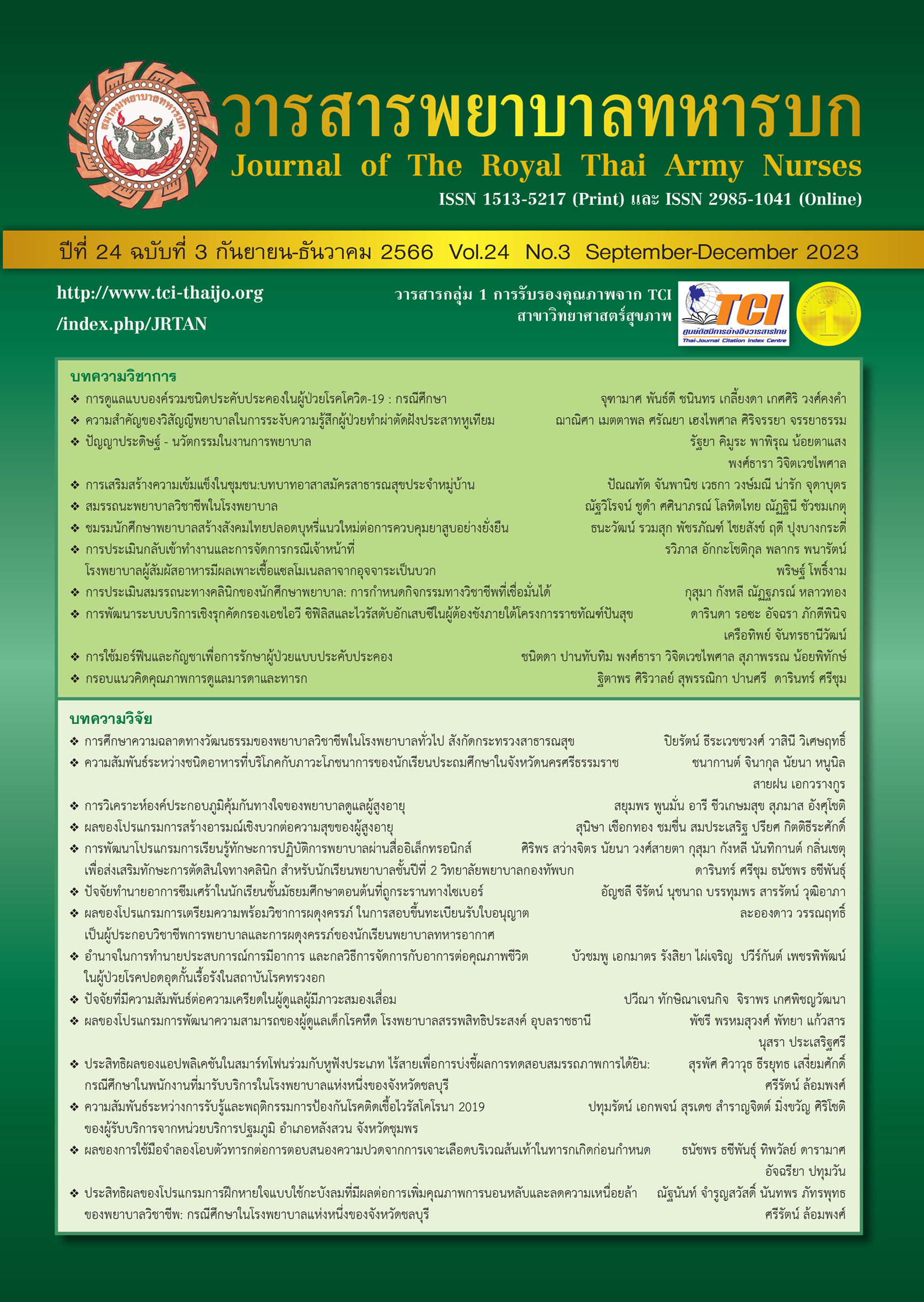Effectiveness of Smartphone-based Application with Wireless Earbuds as Result Indication of Audiometric Testing: Case Study Among Workers in a Hospital, Chonburi Province
Keywords:
Application, Smartphone, Wireless earbuds, AudiometerAbstract
The purposes of this quasi-experimental research were to compare the hearing threshold of participants using a smartphone-based hearing test application with wireless earbuds with conventional audiogram and to determine the accuracy of a smartphone-based hearing test application with wireless earbuds with conventional audiometer. A total of 41 subjects were recruited and completed a questionnaire which had passed verify checked. Pure tone audiogram thresholds were measured from 500 Hz to 8000 Hz, while smartphone measurement was obtained with “Hearing Test” application. All data were analyzed using descriptive statistics, paired t-test and intraclass correlation coefficient (ICC). The statistical significance is determined at p < .01.
The result showed that there was significant difference between the average hearing threshold obtained on smartphone-based application and conventional audiometer for all frequencies. The results from smartphone-based application were significantly lower than the one determined by conventional audiometer for all frequencies. The results also revealed high positive correlation for the frequencies 500-2,000 Hz (ICC 0.61-0.87) and very high positive correlation for the frequencies 3,000-8,000 Hz (ICC 0.90-0.95).
In conclusion, the method of hearing test carried out on smartphone-based application with wireless earbuds demonstrates high compatibility with conventional audiometer, which may serve as an accurate and accessible approach to hearing evaluations, especially in settings where conventional audiometer is unavailable.
Downloads
References
Vos T, Flaxman AD, Naghavi M, Lozano R, Michaud C, Ezzati M, Shibuya K, Salomon JA, Abdalla S, Aboyans V, Abraham J. Years lived with disability (YLDs) for 1160 sequelae of 289 diseases and injuries 1990–2010: a systematic analysis for the Global Burden of Disease Study 2010. The lancet. 2012; 380(9859): 2163-96.
Department of Disease Control, Ministry of Public Health. Occupational and Environment Diseases Report. n.p.: 2018.
Department of Labour Protection and Welfare, Ministry of Labour. Announcement of the Department of Labour Protection and Welfare on Criteria and method for the preparation of hearing conservation program in the workplace, 2018. Government Gazette Volume 135, Part 134d, dated 12th June 2018.
Mirza R, Kirchner DB, Dobie RA, Crawford J, ACOEM Task Force on Occupational Hearing Loss. Occupational noise-induced hearing loss. Journal of occupational and environmental medicine. 2018; 60(9): e498-501.
American Conference of Governmental Industrial Hygienists. The Documentation of The Threshold Limit Values for Chemical Substances and Physical Agents Biological Exposure Indices; 2022.
Health and Safety Executive. Controlling Noise at Work: The Control of Noise at Work Regulations 2005; Guidance on Regulations. HSE Books; 2005.
Occupational Safety and Health Administration. Preventing hearing loss caused by chemical (ototoxicity) and noise exposure. n.p.: 2018.
Pannee Suwannasit, Thitima wonthong, Wanpen Songkham. Prevalence Rate and Factors Associated with Noise-induced Hearing Lossamong Workers in Chumphon Khet Udomsakdi Hospital. Journal of The Royal Thai Army Nurses. 2022; 23(2): 208-17.
Ministry of Industry. Guidelines in Physical Examination for Chemical and Physical Occupational Health Risk Factors in Workplace, 2012. Government Gazette Volume 129, Part 105d, dated 4th July 2012.
Van Tonder J, Swanepoel DW, Mahomed-Asmail F, Myburgh H, Eikelboom RH. Automated smartphone threshold audiometry: validity and time efficiency. Journal of the American Academy of Audiology. 2017; 28(3): 200-8.
Kanyalack Kotchawong. The reliability of hearing test application in smartphone to evaluate for hearing screening in Ranong hospital. Region 11 Medical Journal. 2018; 32(2): 945-54.
Aremu SK. Evaluation of the hearing test pro application as a screening tool for hearing loss assessment. Nigerian Medical Journal: Journal of the Nigeria Medical Association. 2018; 59(5):55-8.
Peer S, Fagan JJ. Hearing loss in the developing world: evaluating the iPhone mobile device as a screening tool. South African Medical Journal. 2015; 105(1):35-9.
Abu-Ghanem S, Handzel O, Ness L, Ben-Artzi-Blima M, Fait-Ghelbendorf K, Himmelfarb M. Smartphone-based audiometric test for screening hearing loss in the elderly. European archives of oto-rhino-laryngology. 2016; 273(3):333-9.
Chu YC, Cheng YF, Lai YH, Tsao Y, Tu TY, Young ST, Chen TS, Chung YF, Lai F, Liao WH. A mobile phone–based approach for hearing screening of school-age children: cross-sectional validation study. Journal of Medical Internet Research mHealth and uHealth. 2019; 7(4): e12033.
Durgut O, Ekim B, Dikici O, Solmaz F, Ağırgöl B, Özbakan A. Evaluation of hearing thresholds by using a mobile application in children with otitis media with effusion. Audiology and Neurotology. 2020; 25(3): 120-4.
Livshitz L, Ghanayim R, Kraus C, Farah R, Even-Tov E, Avraham Y, Sharabi-Nov A, Gilbey P. Application-based hearing screening in the elderly population. Annals of Otology, Rhinology & Laryngology. 2017; 126(1): 36-41.
Chen CH, Lin HY, Wang MC, Chu YC, Chang CY, Huang CY, Cheng YF. Diagnostic accuracy of smartphone-based audiometry for hearing loss detection: meta-analysis. JMIR mHealth and uHealth. 2021; 9(9): e28378.
Rosner B. Fundamentals of biostatistics. 7th ed. Boston: Cengage learning; 2010.
Masalski M, Grysiński T, Kręcicki T. Hearing tests based on biologically calibrated mobile devices: comparison with pure-tone audiometry. Journal of Medical Internet Research mHealth and uHealth. 2018;6(1):e10.
Guo Z, Yu G, Zhou H, Wang X, Lu Y, Meng Q. Utilizing true wireless stereo earbuds in automated pure-tone audiometry. Trends in Hearing. 2021.
Downloads
Published
How to Cite
Issue
Section
License
Copyright (c) 2023 Journal of The Royal Thai Army Nurses

This work is licensed under a Creative Commons Attribution-NonCommercial-NoDerivatives 4.0 International License.
บทความหรือข้อคิดเห็นใดใดที่ปรากฏในวารสารพยาบาลทหารบกเป็นวรรณกรรมของผู้เขียน ซึ่งบรรณาธิการหรือสมาคมพยาบาลทหารบก ไม่จำเป็นต้องเห็นด้วย
บทความที่ได้รับการตีพิมพ์เป็นลิขสิทธิ์ของวารสารพยาบาลทหารบก
The ideas and opinions expressed in the Journal of The Royal Thai Army Nurses are those of the authors and not necessarily those
of the editor or Royal Thai Army Nurses Association.






